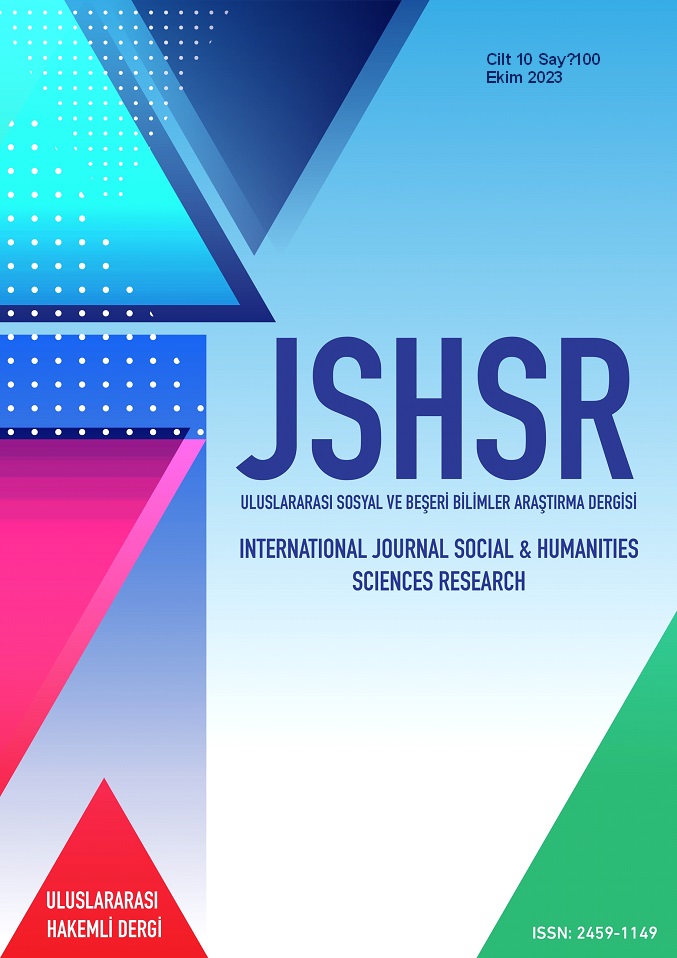Arûz Syllables in the Context of Their Structures and Origins Muhibbî's Ghazals with Gül Redifs
DOI:
https://doi.org/10.5281/zenodo.10035025Keywords:
Arûz syllables, structures of syllables, +DIr/+DUr suffixes (copular)Abstract
Although many academic studies have been carried out on prosody, the number of studies based on numerical data and the results of these data is not at the same level. However, there is a need for prosody-oriented studies based on numerical data in order to evaluate the preferences of poets regarding prosody and to make a comparison between poets or texts. Moreover, the extent to which studies on prosody are needed and what kind of opportunities such studies will provide to researchers will only be possible by providing sufficient numerical data.
In the light of these evaluations, in the study, the gül rhymed ghazals of Muhibbî, one of the sultan poets of the 16th century, were examined and evaluated in terms of arûz syllables. In this context, 15 ghazals with gül rhymes were identified in the poet's published divan, and the total number of couplets in the ghazals is 90. Considering the meter of the relevant couplets, it was determined that the number that should have been 2.652 decreased to 2.505 due to the meds. After examination and evaluation, numerical data regarding the structures and origins of the syllables in the ghazals in question were presented. Afterwards, the data were analyzed and the remarkable results were shared. In this context, questions such as which type of syllables are mostly used in the texts written with arûz and which languages the roots of the syllables belong to have been tried to be answered in this context.
References
Ak, C. (1987). Muhibbî Dîvânı, Kültür ve Turizm Bakanlığı Yay.
Aksoy, Ö. A. ve Dilçin D. (2009). XIII. Yüzyıldan Beri Türkiye Türkçesiyle Yazılmış Kitaplardan Toplanan Tanıklarıyla Tarama Sözlüğü. C. I-VIII, Türk Dil Kurumu Yay.
Ali N. ve Faik R. (2005). Mükemmel Osmanlı Lügatı (haz. Nejat Birinci vd.), Türk Dil Kurumu Yay.
Bayram, Y. (2022a). Arûz Tasarrufları Bağlamında Bir Gül Kasidesi (Fuzûlî). Divan Edebiyatı Araştırmaları Dergisi, 29, 359-383.
Bayram, Y. (2022b). Arûz Tasarrufları Bağlamında Üç Gül Kasidesi (Necâtî, Hayâlî, Nev‘î). Eski Türk Edebiyatı Araştırmaları Dergisi, 5(3),1682-1750.
Çağbayır, Y. (2007). Orhun Yazıtlarından Günümüze Türkiye Türkçesinin Söz Varlığı Ötüken Türkçe Sözlük, C.1-5, Ötüken Yayınları.
Devellioğlu, F. (2013). Osmanlıca-Türkçe Ansiklopedik Lûgat. Aydın Kitabevi.
Digital Dictionaries of South Asia (t.y.). https://dsal.uchicago.edu/dictionaries/
El Meânî (t.y.). https://www.almaany.com/tr/dict/ar-tr/
Ferheng-i Lügat-ı Fârisî-Türkî İstânbûlî (t.y.). https://fa. glosbe.com/fa/tr
Kâmus-ı Türkî (t.y.). www.kamusiturki.com
Kâmûsu’l-Nuhît Tercümesi ve Vankulu Lügati (t.y.). http://www.kamus.yek.gov.tr
Kanar, M. (2003). Örnekli Etimolojik Osmanlı Sözlüğü, Derin Yay.
Kanar, M. (2008). Farsça-Türkçe Sözlük, Say Yay.
Kanar, M. (2012). Arapça-Türkçe Sözlük, Say Yay.
Kanar, M. (2018). Eski Anadolu Türkçesi Sözlüğü, Say Yay.
Kubbealtı Lügati (t.y.). www.kubbealtilugati.com (www.lugatim.com)
Nişanyan Sözlük (t.y.). https://www.nisanyansozluk.com
Osmanlıca Lügat (t.y.). https://lugat.osmanlica.online
Osmanlıca Sözlükler (t.y.). www.osmanlicasozlukler.com
Paçacıoğlu, B. (2016). VIII.-XVI. Yüzyıllar Arasında Sözcük Dağarcığı, Kesit Yay.
Parlatır, İ. (2012). Osmanlı Türkçesi Sözlüğü, Yargı Yay.
Redhouse, Sir James William (1999). Redhouse Türkçe/Osmanlıca- İngilizce Sözlük. Sev Yayıncılık.
Şemseddin Sâmî (2018). Kâmûs-ı Türkî (Latin Harfleriyle) (haz. Raşit Gündoğdu vd.), İdeal Kültür Yay.
Tanıklı Türkçe Sözlük (t.y.). www.lehcediz.com
Tulum, M. (2011). 17. Yüzyıl Türkçesi ve Söz Varlığı. Türk Dil Kurumu Yay.
Tulum, M. (2023). Arapça ve Farsça’dan Osmanlı Türkçesine Alıntılar Sözlüğü, C.1, Ketebe Yay.
Türk Dili Kurumu Sözlükleri (t.y.). www.sozluk.gov.tr
Türk Edebiyatı Tarihsel Sözlüğü (t.y.). www.tebdiz.com
Vâjehyâb (t.y.). https://www.vajehyab.com
Yavuz K. ve Yavuz O. (2016). Muhibbî Dîvânı, C.2, Türkiye Yazma Eserler Kurumu Başkanlığı Yay.
Downloads
Published
How to Cite
Issue
Section
License
Copyright (c) 2023 INTERNATIONAL JOURNAL OF SOCIAL HUMANITIES SCIENCES RESEARCH

This work is licensed under a Creative Commons Attribution 4.0 International License.


